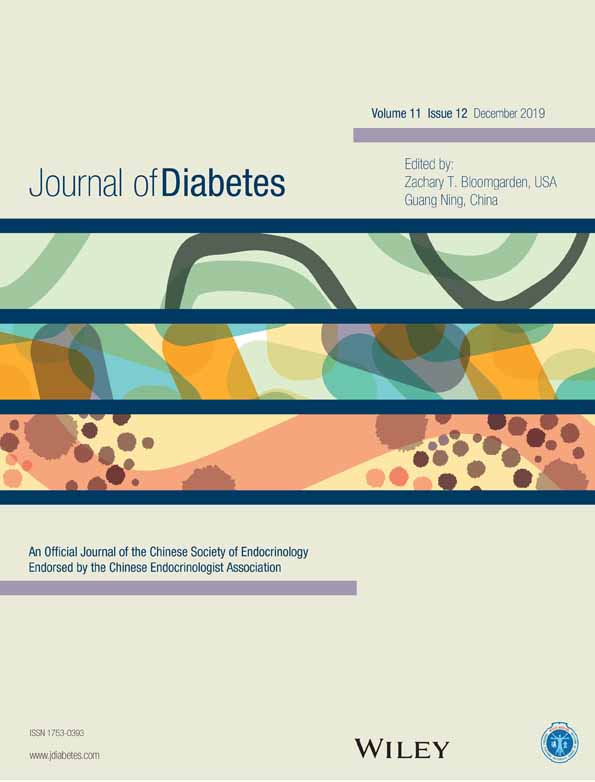Acupuncture for painful diabetic neuropathy
针灸治疗痛性糖尿病神经病变
The treatment of painful diabetic peripheral neuropathy is often unsatisfactory, with existing pharmacologic management approaches only providing limited pain relief, often with significant side effects, particularly weight gain and sedation. Several studies of acupuncture for treatment of neuropathic pain have been carried out. Although earlier trials had methodologic issues,1 two recent randomized controlled trials suggest this to be a potentially useful approach.2, 3
In the present issue of the Journal of Diabetes, Pan and coworkers have examined a potential mechanistic explanation of the effect of acupuncture in reducing peripheral neuropathic damage in diabetes. Sensory and motor nerve conduction velocity were reduced in a diabetes model and partially restored by a 12-week course of 6-times-weekly acupuncture treatment. Reasoning that diabetes may lead to neuronal apoptosis by causing endoplasmic reticulum stress, molecular mediators of apoptosis, glucose-regulated protein 78 and caspace-12, which were elevated in the diabetes model, were nearly completely normalized, with improvement in pathologic findings of disruption of myelinated nerve fibers and with reduction in apoptosis.
A dilemma for the reader trained in Western medicine is the interpretation of the intervention, which the authors term “adjusting internal organs and dredging channels.” This refers to the insertion of a set of seven electrodes on each side of the torso, with application of low-frequency electric stimuli. In the view of Western medicine, the authors’ description of the pathogenesis of diabetic complications as involving factors such as “yin liquid insufficiency” makes little sense. If, however, we look at these terms as empiric labels developed over the course of millennia in characterizing specific points on the human (and, apparently, the overall mammalian) body, useful in a variety of interventions addressing pain and related conditions, then the scientific investigation of these treatments makes very good sense. If one further considers the extraordinarily high population prevalences of painful conditions, including that of neuropathic pain, one of the major contributors to years lived with disability, and the high economic burden of pain,4 then it behooves us to regard studies such as the present one as being of great potential importance.
The task of a medical journal editor is in certain ways an unenviable one. We receive somewhat over 600 manuscript submissions each year, of which we consider about one third of sufficient interest to deserve external review. In 2017 and in 2018, in order to obtain two to three reviews, we invited eight to ten reviewers per article. This has particularly been an issue for topics such as the present study of acupuncture, or for studies of Yoga practice or physical activity, for which 20 or more reviewers are often invited. Nonetheless, we continue to search for 明珠,the bright pearls of knowledge, which will improve our understanding and management of diabetes and its many associated complications.
痛性糖尿病周围神经病变的治疗效果通常不能令人满意,现有的药物治疗方法对疼痛的缓解作用有限,而且常常伴有明显的副作用,尤其是体重增加与药物镇静作用。目前已经开展了几项针灸治疗神经性疼痛的研究。尽管早期的试验存在方法学问题1,但最近的两项随机对照试验表明,这是一种潜在的有效治疗方法2,3。
在本期的Journal of Diabetes上,Pan及其同事们研究了针灸减轻糖尿病周围神经病变的潜在机制。糖尿病模型中感觉和运动神经传导速度降低,每周6次针灸治疗、共治疗12周可使神经传导速度部分恢复。糖尿病可能通过引起内质网应激导致神经元凋亡,细胞凋亡的分子介质葡萄糖调节蛋白78与半胱氨酸天冬氨酸蛋白酶-12(caspace-12)在糖尿病模型中均升高,针灸治疗后几乎完全恢复正常,有髓神经纤维断裂的病理结果改善,细胞凋亡减少。
对于接受西医培训的读者来说,如何解释这种干预治疗的效果是一个两难的问题,作者将其称之为“调节内脏,疏通经络”。这是指在躯干的两侧各插入一组7个电极,并施加低频电刺激。在西医看来,作者将糖尿病并发症的发病机制描述为诸如“阴液不足”等病因,是无法理解的。然而,如果我们将这些术语视为几千年来在描述人类(显然,这可以扩展到整个哺乳动物)身体特定位点开发的经验性标签,可用于各种针对疼痛与相关疾病的干预措施,那么这些治疗的科学研究就非常有意义。如果进一步考虑到人群中疼痛性疾病的患病率极高(包括神经性疼痛,其是导致多年残疾的主要因素之一)和高昂的经济负担4,那么我们应该认为当前这样的研究具有潜在的重要意义。
医学期刊编辑在某些方面的任务并不令人羡慕。我们每年收到大约600多份稿件,其中约1/3的稿件我们感到有兴趣,认为值得外部审稿。在2017年和2018年,为了获得2-3个审稿意见,每篇文章我们都邀请了8-10位审稿人。尤其是一些特殊主题的研究,例如当前这项针灸研究,或是瑜伽或体育活动的研究,通常会邀请20位甚至更多的审稿人。尽管如此,我们仍在继续寻找知识的璀璨明珠,这将有助于提高我们对糖尿病及其多个相关并发症的理解与管理。




